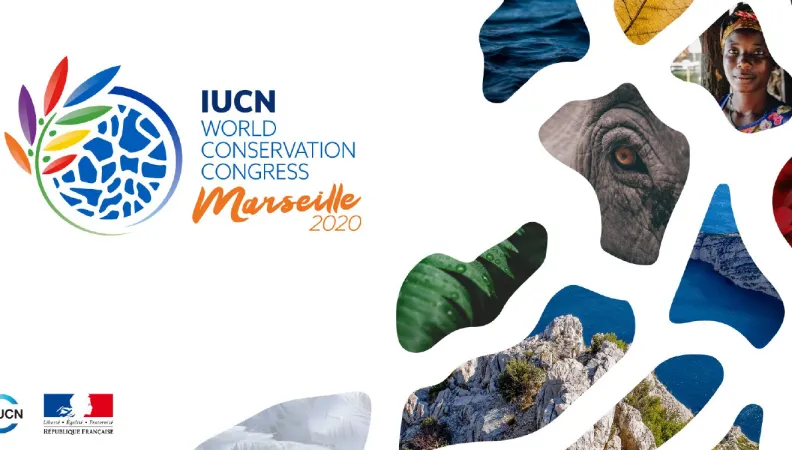Share the page
Lessons learned from the IUCN World Conservation Congress
Published on

The World Conservation Congress of the International Union for Conservation of Nature (IUCN) took place on September 3–11 in Marseille. This gathering helped put biodiversity protection high on the international agenda. We sum up six of the most important lessons to be learned from the conference.
Mobilization for biodiversity is strong.
“This Congress was a high point of mobilization for biodiversity,” says Gilles Kleitz, Director of the Ecological Transition Department at AFD. Indeed, it was attended by 4,000 participants from civil society, governments, companies, and universities—not to mention by several thousand more online.
What’s more, the Congress consisted of nearly 1,300 interactive sessions in the form of round tables, displays, training sessions, and visits. They all focused on various aspects of biodiversity, such as protected areas, mainstreaming, financing, and nature-based solutions. And it wasn’t just idle talk, as Gilles Kleitz tells us: “A consensus is now emerging on the two main responses to the biodiversity crisis: protecting nature and greening the economy and finance. These two responses are complementary and should be the two pillars of the agreement to be reached in spring 2022 at COP 15 in China.”
See also: The IUCN World Conservation Congress in 8 Points
AFD had a strong presence at the Congress sessions, where it highlighted the importance of greening the economy and the catalyzing role that can be played by public development banks, including AFD itself and its partners in the International Finance Development Club (IDFC) and the Finance in Common network.
Funding for nature is still insufficient.
This major challenge linked to the biodiversity crisis was a focus of discussions at the IUCN Congress. In particular, how can we succeed in “greening” international financial players, so that they stop supporting projects that harm ecosystems and instead invest massively to conserve them?
As AFD CEO Rémy Rioux says, “Current investment in nature must be expanded seven-fold.” In fact, while the needs for financing global biodiversity will reportedly grow to between $722 billion and $967 billion per year by 2030, only $124 billion to $143 billion is actually being devoted to such financing.
At the conference, AFD emphasized that public development banks have a crucial role to play in this issue: they must interest investors—especially private investors—in projects that benefit biodiversity, while at the same time discourage them from making harmful investments.
Nature-based solutions must be found and implemented.
The IUCN Congress put nature-based solutions in the global spotlight. These are actions designed to protect, sustainably manage, or restore natural or modified ecosystems. They are a direct response to the challenges facing society and, of course, to climate change.
AFD provided funding to IUCN for developing its Global Standard in 2020, which is designed to better think out and implement nature-based solutions. It’s now essential that all stakeholders put these solutions into action on the ground.
Fighting for biodiversity and fighting for the climate are the same.
One of the key conclusions from the World Conservation Congress was that climate protection and biodiversity protection are closely interlinked. Many players, including France, called for actions defending both of these common goods to converge in a global struggle for the future of the planet.
In its closing statement, IUCN emphasized this important point: “The climate and biodiversity emergencies are not distinct, but two aspects of one crisis. [...] Our response to these emergencies must be mutually reinforcing. For example, measures designed to address climate change must not lead to further biodiversity loss.”
See also: €1 Billion for Biodiversity
At AFD Group, one of our objectives is to double our financing for biodiversity, from €565 million per year in 2020 to €1 billion by 2025, and by that same year also make 30% of our climate financing benefit nature.
Despite the biodiversity emergency, there is hope.
The World Conservation Congress closed on Friday, September 10 with the publication of the “Marseille Manifesto.” This declaration adopted by the IUCN members offers hope in the face of the decline in plant and animal species.
In its Manifesto, IUCN urges the following:
Humanity has reached a tipping point. Our window of opportunity to respond to these interlinked emergencies and share planetary resources equitably is narrowing quickly. Our existing systems do not work. Economic “success” can no longer come at nature’s expense. We urgently need systemic reform. Yet there is reason to be optimistic. We are perfectly capable of making transformative change and doing it swiftly. [...] To invest in nature is to invest in our collective future.
As a follow-up to the One Planet Summit, IUCN has called for 30% of the planet—both land and sea—to be protected by 2030.
The Marseille Congress was a step forward to the Kunming COP15.
This highly awaited Congress was the first major global meeting of the international biodiversity agenda. It’s a process that should lead to a global agreement on the protection of nature (the “post-2020 framework”) in the spring of 2022 at COP15 of the Convention on Biological Diversity, which will take place in Kunming, China.
IUCN’s manifestos and motions are above all calls to action, because we still have a long way to go. In any event, this Congress will always be seen as a very valuable moment of dialogue, meetings, and consensus building. More precise ideas for action are beginning to emerge, and mobilization on the issues will continue so that concrete actions can be determined in six months, in China.
Menu latéral
$(document).ready(function() {
$('#most_viewed_nodes_block').replaceWith($('#mi'));
});
IUCN Series
3 Questions on the IUCN World Conservation Congress The IUCN World Conservation Congress in 8 Points France and AFD, Key Partners of IUCN How Public Development Banks can Support Biodiversity Costa Rica and France's Southeast: A Partnership for Biodiversity at the World Conservation Congress One Planet Summit: Eight Months on, Progress on Biodiversity Main Menu
